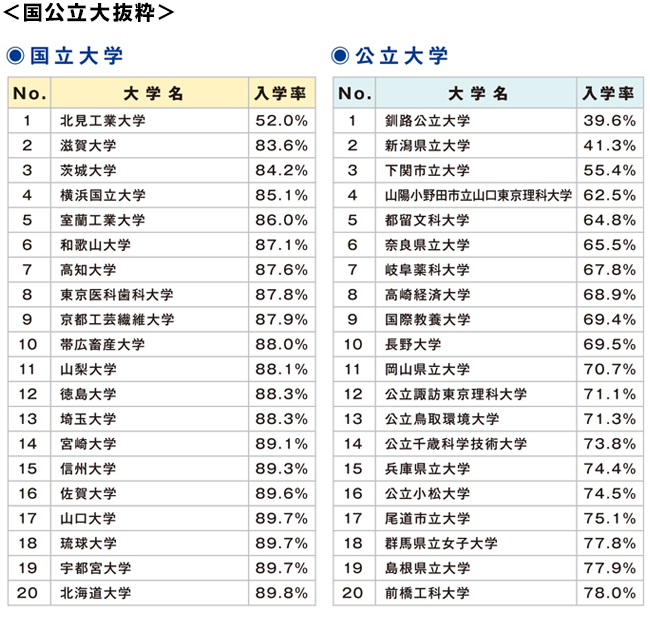Surprisingly low enrollment rates at some national and public universities

You can check the status of individual universities by looking at the <National and Public Universities Excerpt>.At the national university, Kitami Institute of Technology does not apply for admission even if nearly half pass.It can be inferred that you have gone on to another university or have gone to a prep school.In addition, the enrollment rate tends to be low at universities relatively close to the metropolitan area such as Ibaraki University, Utsunomiya University, and Yamanashi University, and surprisingly, leading universities in the metropolitan area such as Yokohama National University and Saitama University are also among the national universities. You can see that the enrollment rate is low.The urban areas are full of traditional and influential private universities.Normally, it seems that many people choose national universities that are price-competitive, that is, the tuition fees are overwhelmingly cheap, but there are cases where private universities are selected to a certain extent.Shiga University and Kyoto Institute of Technology are also close to urban areas, which is thought to be due to these influences.
The reason why the enrollment rate of public universities is low is that many universities have 3 to 4 subjects in the common test for university admission, and it is easy for private university applicants to apply for the same term. This is probably because there are many universities.The mid-term schedule can be applied for both the first-half schedule and the second-half schedule.Of course, if you pass the first semester and complete the admission procedure, you will be excluded from those who passed the middle semester, but those who passed the second semester can be selectively selected after the pass / fail result is obtained. ..In addition, the University of Niigata and Akita International University have different admission schedules from other national and public universities, so the admission rate is low.Looking at it in this way, the entrance examination system of public universities seems to be the best of both worlds and private universities.

Is there a possibility that the exam structure will be a domino effect that is advantageous to the examinees?
Both private and public universities are easily affected by changes in the entrance examination methods of national universities in neighboring areas, so the enrollment rate will inevitably change when a new faculty is established at a national university in the same prefecture.As mentioned above, even in the 2022 entrance examination, some national universities are reorganizing and establishing new faculties.When a new faculty is established, the number of successful applicants will increase.Such national and public universities and private universities, which have many applicants, may announce the number of successful applicants more than usual in anticipation of this.In particular, in the 2021 entrance examination, there were cases where the enrollment rate decreased at many private universities, and for that reason, it is expected that the number of private universities that pass the 2022 entrance examination will increase more than usual. ..If it is an urban area, a national university that is inferior to a leading private university may take this into consideration and increase the number of successful applicants.It seems to be a domino effect, but if this happens, it will be a very thankful examination structure for the examinees.
Furthermore, it goes without saying that the actual number of university applicants is decreasing, which is an advantage for examinees.Therefore, depending on the region or faculty system, the hurdles for entrance examinations at national universities have dropped considerably.As the impact spreads to the surrounding universities, the hurdles for the entire entrance examination in that area will be lowered.Even if the average score of the Common Test for University Admissions next year drops and does not reach the target score, there is a slight possibility that it will open the way for the examinees, unless they are aiming for a specific difficulty level. I am.
- 1
- 2
